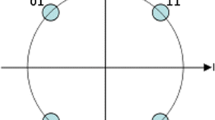Abstract
Based on orthogonal designs, space-time (ST) block codes that enable full diversity as well as a simple maximum likelihood (ML) decoding algorithm at the decoder can be constructed for more than two transmit antennas. For real constellations (such as PAM), ST block codes with transmission rate 1 can be designed from the real Hurwitz-Radon families for any number of transmit antennas. However, for complex constellations (such as M-PSK or M-QAM), ST block codes for more than two transmit antennas can only be constructed with rates less than 1. Previous attempts have been concentrated on complex orthogonal designs that provide ST block codes with full diversity and high transmission rates. In this paper, we present two rate 2/3 complex ST block codes from orthogonal designs for five and six transmit antennas, respectively. Simulation results are provided to demonstrate the significant performance gains made by the proposed ST block codes.
Similar content being viewed by others
References
Tarokh V., Jafarkhani H. and Calderbank A.R. (1999). Space-time block codes from orthogonal designs. IEEE Transactions on Information Theory 45: 1456–1467
Alamouti S. (1998). A simple transmit diversity technique for wireless communications. IEEE Journal of Selected Areas in Communication 16: 1451–1458
Su W. and Xia X.-G. (2003). Two generalized complex orthogonal space-time block codes of rates 7/11 and 3/5 for 5 and 6 transmit antennas. IEEE Transactions on Information Theory 49: 313–316
Wang, H., & Xia, X.-G. (2002). Upper bounds of rates of space-time block codes from complex orthogonal designs. In Proceedings IEEE International Symposium on Information Theory (ISIT’02), July 2002, pp. 303.
Liang X.-B. (2003). Orthogonal designs with maximal rates. IEEE Transactions on Information Theory 49: 2468–2503
Gong Y. and Letaief K.B. (2002). Concatenated space-time block coding with trellis coded modulation in fading channels. IEEE Transactions on Wireless Communication 1(4): 580–590
Ganesan G. and Stoica P. (2001). Space-time block codes: A maximum SNR approach. IEEE Transaction on Information Theory 47: 1650–1656
Tarokh V., Jafarkhani H. and Calderbank A.R. (1999). Space-time block coding for wireless communications: performance results. IEEE Journal of Selected Areas in Communication 17: 451–460
Author information
Authors and Affiliations
Corresponding author
Rights and permissions
About this article
Cite this article
Xu, C., Gong, Y. & Yang, W. High-rate Complex Orthogonal Space-time Block Codes for 5 and 6 Transmit Antennas. Wireless Pers Commun 49, 263–274 (2009). https://doi.org/10.1007/s11277-008-9571-5
Received:
Accepted:
Published:
Issue Date:
DOI: https://doi.org/10.1007/s11277-008-9571-5




